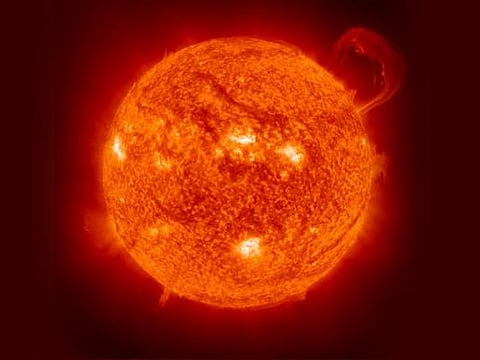

BENGALURU: After India scripted history by successfully launching the Chandrayaan-3 mission to the Moon’s south pole on August 23, the next mission lined up within five days is Aditya-L1, the country’s first mission to the Sun which will be launched at 11.50 am on September 2 from the Sriharikota spaceport.
The Indian Space Research Organisation (ISRO) on Monday said on platform X, “The launch of Aditya-L1, the first space-based Indian observatory to study the Sun, is scheduled for September 2, 2023, at 11:50 Hrs. IST from Sriharikota.” The mission will be on ISRO’s PSLV-C57 rocket.
The ambitious Aditya-L1 mission is designed to provide remote observations of the solar corona and in-situ observations of the solar wind at L1 (Sun-Earth Lagrange Point), which is about 1.5 million kilometre from the Earth. The spacecraft is a fully indigenous effort of ISRO.
According to scientists, the Lagrange Points -- named after Italian-French mathematician Josephy-Louis Lagrange -- are positioned in space where the gravitational forces of the Sun and the Earth produce enhanced regions of attraction and repulsion, which the spacecraft will use to its advantage to reduce fuel consumption and remain in position.
The mission to the Sun aims at observing the solar atmosphere, mainly the chromosphere and corona -- outermost layers of the Sun -- and conduct in-situ experiments to record the local environment at L1. Aditya-L1 will have seven payloads, which will record and provide crucial information to understand the problem of coronal heating, coronal mass ejection, pre-flare and flare activities and their characteristics, dynamics of space weather, propagation of particles and fields. Of the seven payloads, four are for remote sensing of the Sun, while three will carry out in-situ observation.
A satellite will be placed in the halo orbit around the L1 point which will have a major advantage of continuously viewing the Sun without any planets obstructing the view or causing eclipses, ISRO said in a statement. “This will provide a greater advantage of observing the solar activities and its effect on space weather in real-time,” it said.
The satellite, developed by the UR Rao Satellite Centre, arrived at Sriharikota in Andhra Pradesh earlier this month. The space agency has also invited registrations for the live viewing of the launch from the Launch View Gallery at Sriharikota. Interested individuals can register through https://lvg.shar.gov.in/VSCREGISTRATION/index.jsp
Close call for Pragyaan with 4-metre-diameter crater
Chandrayaan-3’s Pragyaan rover had a close call with a 4-metre-diameter crater in the vicinity of the mission’s landing site on Sunday. However, Pragyaan rerouted itself just in time to prevent it from entering the crater. It detected the crater just 3 metres short of it. Had the rover failed to detect it, and entered it, it would have been difficult for it to come out, compromising its operations. On Sunday, the rover traversed a 10-cm-deep ditch, but because of its track and wheels, it was able to come out. However, the crater appears to be much deeper than the ditch.
ISRO on platform X said, “The rover came across a 4-metre diameter crater positioned 3 metres ahead of its location. The rover was commanded to retrace the path. It’s now safely heading on a new path.” It also released images of the lunar crater and detour of the rover, its path marked by the imprints on the lunar soil left behind by the rover’s wheels and track, which have been recorded by the navigation camera on board. The rover’s retraction was commanded by the ISRO team at Mission Operation Complex (MOX) situated in ISRO Telemetry, Tracking and Command Network (ISTRAC) in Bengaluru. The signals from the rover were sent to the Vikram lander, which in turn communicated them to ISTRAC, which commanded the evasive action by the rover to avoid the crater.